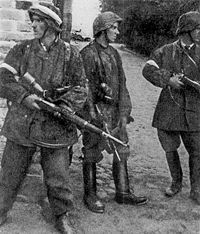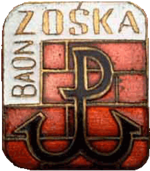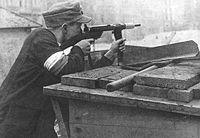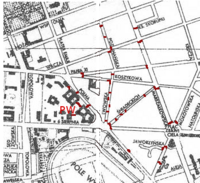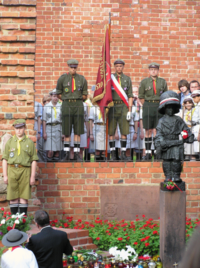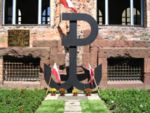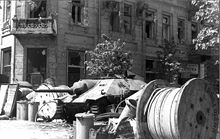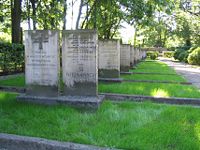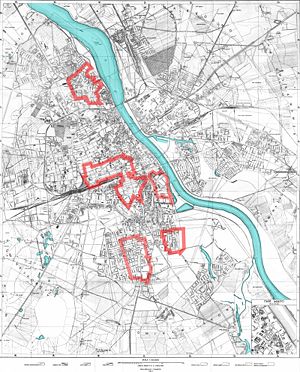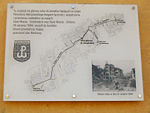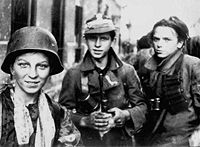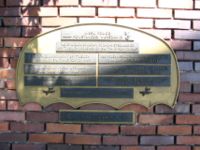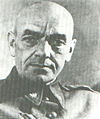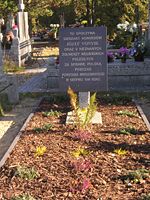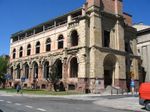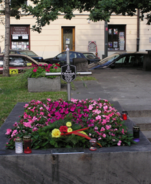Warsaw Uprising
2008/9 Schools Wikipedia Selection. Related subjects: World War II
| Warsaw Uprising | |||||||
|---|---|---|---|---|---|---|---|
| Part of AK " Operation Tempest", World War II | |||||||
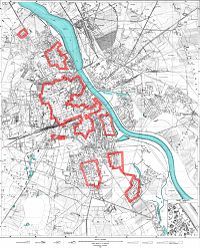 Polish Home Army positions, outlined in red, on day 4 ( August 4, 1944). |
|||||||
|
|||||||
| Belligerents | |||||||
|
Poland |
Nazi Germany |
||||||
| Commanders | |||||||
| Tadeusz Komorowski # Antoni "Monter" Chruściel # Tadeusz Pełczyński |
Erich von dem Bach Rainer Stahel Heinz Reinefarth Bronislav Kaminski † Petro Dyachenko |
||||||
| Strength | |||||||
| 47,500 troops | 25,000 troops (initially) | ||||||
| Casualties and losses | |||||||
| Berling 1st Army: 5,660 Casualties Polish Insurgents: 15,200 killed, 5,000 wounded, 15,000 taken prisoner Civilians: 200,000 killed 700,000 expelled from the city |
16,000 killed, 9,000 wounded, 300 tanks and armored cars, 340 trucks and cars, 22 light artillery pieces |
||||||
|
|||||
| Warsaw Uprising |
| Prelude - The Battle Lack of outside support Capitulation - Aftermath Planned destruction Cultural representations Military units - Notable people Atrocities |
The Warsaw Uprising (Powstanie Warszawskie) was a World War II struggle by the Polish Home Army (Armia Krajowa) to liberate Warsaw from German occupation. The Uprising began on August 1, 1944, as part of a nationwide rebellion, Operation Tempest. It was intended to last for only a few days until the Soviet Army would reach the city. The Soviet advance stopped short, however, while Polish resistance against the German forces continued for 63 days (until October 2).
The Uprising began at a crucial juncture as the Soviet Army was approaching Warsaw. The Uprising's chief objective was to drive the German occupiers from the city, helping with the larger fight against the Axis. Secondary political objectives were to liberate Warsaw before the Red Army arrived, so as to underscore Polish sovereignty, and to undo the Allied division of Central Europe into spheres of influence. Polish authorities were to reappear in liberated Warsaw and challenge the Soviet puppet government that was to rule Poland.
By September 16, 1944, Soviet forces had reached a point a few hundred metres from the city, across the Vistula River, but they made no further headway during the Uprising leading to allegations that Joseph Stalin had wanted the insurrection to fail.
Polish losses amounted to 18,000 soldiers killed and 25,000 wounded, in addition to between 120,000 and 200,000 civilian deaths, mostly from mass murders conducted by retreating German troops. German casualties totalled over 17,000 soldiers killed and over 9,000 wounded. During the urban combat approximately 25% of Warsaw's buildings were destroyed. Following the surrender of Polish forces on October 2, German troops systematically burned the city block by block. Together with earlier damage suffered in 1939 and during the Warsaw Ghetto Uprising (1943), over 85% of the city had been destroyed. By January 1945, when the Soviets finally entered the city, Warsaw had practically ceased to exist.
Eve of battle
| “ | If not for Warsaw in the General Government, we wouldn't have 4/5 of our current problems on that territory. Warsaw was and will be the centre of chaos and a place from which opposition spreads throughout the rest of the country. | ” |
|
—German Governor-General Hans Frank |
||
The Warsaw Uprising, or at least some form of insurrection in Poland, had been planned long in advance. From its inception, the Home Army was planning a national uprising against the German forces. Initial plans created by the Polish government-in-exile in 1942 assumed that the Allied invasion of Europe would lead to the withdrawal of considerable German forces from the Eastern Front for the defence of the Third Reich. The Home Army would act to prevent troop transfer to the west and to allow the British and American forces to seize Germany by breaking all communication links with the majority of the German forces massed in the Soviet Union.
The Home Army's initial plans for a national uprising, Operation Tempest, which would link up with Western Allies forces, changed in 1943 when the situation on the Eastern Front made it apparent that the Red Army, rather than the Western Allies, would force the Germans from Poland. By 1943 it was clear that the allied invasion of Europe would not come in time, and that in all probability the Red Army would reach the pre-war borders of Poland before the invasion could make notable headway. In February 1943, General Stefan Rowecki amended the plan. The Uprising was to be started in three phases, the first being in the East (with main centres of resistance in Lwów and Wilno), before the advancing Red Army. The second part was to include armed struggle in the belt between the Curzon Line and the Vistula river, while the third phase was to be a nationwide uprising throughout Poland. Warsaw was chosen, partially, because of its status as a pre-war capital and partly because it was assumed that the Germans would wish to hold onto the city for as long as possible, as a tool for morale boosting, and as a base for communications, supply, and troop movements.
The Polish government-in-exile carried out frantic diplomatic efforts to gain support from their allies prior to the start of battle. However the Allies support for the Polish resistance was not high on the priority list. The Polish government in London asked the Special Operations Executive (SOE) and the Foreign Office several times for an allied mission to be sent to Poland; since such missions had already been dispatched to all other resistance movements in Europe, such as Albania, Czechoslovakia, France, Greece, Italy, Norway, Yugoslavia. However, the Polish pleas were not heeded until December 1944.
For the Soviets, this represented more of a hindrance than a help. Polish-Soviet relations were broken off on April 25, 1943 as a result of the Katyn massacre and Soviet partisans often clashed with Polish partisans. It became obvious that the advancing Red Army might not come to Poland as a liberator but rather, as General Stefan Grot-Rowecki put it, as "our Allies' ally." On November 26, 1943, the Polish government-in-exile issued an instruction to the effect that if diplomatic relations with the Soviet Union were not resumed before the Soviet entry into Poland, Home Army forces were to remain underground pending further decisions. However, the Home Army commander took a different approach, and on November 30, 1943, the final version of the plan, which became known as Operation Tempest, was devised. Although doubts existed about the military wisdom of a major uprising, planning continued nonetheless.
The situation came to a head on 13 July as Operation Bagration, the Soviet offensive, crossed the old Polish border. At this point the Poles had to make a decision: either initiate the uprising in the current difficult political situation and risk problems with Soviet support, or fail to rebel and face Soviet propaganda describing Armia Krajowa as collaborators and ineffective cowards. The plan was intended both as a political manifestation of the influence of Polish Government in Exile and as a direct operation against German occupiers. The fear was that in the aftermath of the war the Allies would ignore the legal London-based government. It was clear both that Poland would be 'liberated' by the Red Army, and that the Soviet Union did not recognise the Government-in-Exile. The urgency for this decision increased as it became clear that after any successful Polish-Soviet co-operation in the liberation of various towns (for example, in the Operation Ostra Brama), the Soviet NKVD units who followed behind would either shoot or arrest most Polish officers and those Polish soldiers who could not or would not join the Soviet controlled forces. Following a flood of reports from the eastern territories about forced demilitarisation, trials and execution of Home Army soldiers by the Soviets, on 21 July 1944 the High Command of the Home Army decided to expand the scope of Operation Tempest to include Warsaw itself. The date for the Warsaw Uprising was set as 1 August. On 25 July the Polish government in exile in London approved the planned uprising in Warsaw.
In the early summer of 1944, German planning required Warsaw to serve as the defensive centre of the area and to be held at all costs. The Germans had fortifications constructed and built up their forces in the area. This process slowed after the failed July 20 Plot to assassinate Adolf Hitler, but by late July 1944, German forces had almost reached their full strength again. On July 27, the head of the General Government, Hans Frank, called for 100,000 Polish men between the ages of 17–65 to present themselves at several designated meeting places in Warsaw the following day, as part of the plan which envisaged the Poles constructing fortifications for the Wehrmacht in and around the city. The Home Army viewed this move as an attempt to neutralise the underground forces, and the underground urged Warsaw inhabitants to ignore it. Fearing German reprisals following the ignored order, and believing that time was of the essence, General Tadeusz Bór-Komorowski ordered full mobilisation of Home Army forces in the Warsaw area on 1 August 1944.
This mobilization decision had some key ramifications for the Soviet Union. Stalin decried for not being officially consulted on the uprising and thus suspected subterfuge from his Western allies. In retrospect, both sides were jockeying for regional political alignment, with the Polish Home Army's desire for a pro-Western Polish government and the Soviet's intention of establishing a Polish Communist regime.
The official Soviet propaganda line tried to portray the Polish underground as "waiting with their arms at ease" and not fighting the common enemy. As the Soviet forces approached Warsaw in June and July 1944, Soviet radio stations demanded a full national uprising in Warsaw to cut the communication lines of German units still on the right bank of the Vistula; just two days prior to the uprising, Soviet-controlled radio Kosciuszko had called for the Polish people to rise in arms. On July 29 , 1944, the first Soviet armoured units reached the outskirts of Warsaw, but were counter-attacked by German 39th Panzer Corps, comprising 4th Panzer Division, 5th SS Panzer Division, 19th Panzer Division, and the Hermann Goering Panzer Division. By 10 August, in the ensuing battle of Radzymin, the Germans had enveloped and inflicted heavy casualties on the Soviet 3rd Tank Corps at Wołomin, 15 kilometres outside Warsaw.
Opposing forces
Poles
The Home Army forces of the Warsaw District numbered about 45,000 soldiers, of which 23,000 were equipped and combat-ready; about 2,500 further soldiers came from the ranks of other formations like the far-right Narodowe Siły Zbrojne and the communist Armia Ludowa. Most of them had trained for several years in partisan and urban guerrilla warfare, but lacked experience in prolonged daylight fighting. The forces lacked equipment, especially since the Home Army had shuttled weapons and men to the east of the city before the decision on 21 July to include Warsaw in Operation Tempest. A number of other partisan groups also subordinated themselves to Home Army command for the uprising. Many volunteers, including some Jews freed from the concentration camp in the ruins of the Warsaw Ghetto, joined during the fighting.
General Antoni Chruściel, codename 'Monter', commanded the Polish forces in Warsaw. Initially he divided his forces into eight areas:
- Area I ( Śródmieście, Old Town)
- Area II ( Żoliborz, Marymont, Bielany)
- Area III ( Wola)
- Area IV ( Ochota)
- Area V ( Mokotów)
- Area VI (Praga)
- Area VII ( Powiat Warszawski)
- Zgrupowanie Kedywu Komendy Głównej
On September 20 a re-organisation of this structure took place to align with the structure of Polish forces fighting with the Western Allies. The entire force, renamed the Warsaw Home Army Corps (Warszawski Korpus Armii Krajowej) and commanded by General Antoni Chruściel (Monter), formed into three infantry divisions.
As of August 1 their military supplies consisted of:
- 1,000 rifles
- 1,700 pistols
- 300 machine pistols
- 60 submachine guns
- 7 machine guns (medium or light, such as the MG 42)
- 35 anti-tank guns and anti-tank rifles (including several PIATs)
- 25,000 hand grenades (mainly of the 'stick' variety).
In the course of the fighting the Poles obtained further supplies through airdrops and by capture from the enemy (including several armoured vehicles). Also, the insurgents’ workshops worked busily throughout the uprising, producing 300 automatic pistols, 150 flame-throwers, 40,000 grenades, a number of mortars, and even an armoured car ( Kubuś).
Germans
In late July the German units stationed in and around Warsaw were divided into three categories. The first - and the most numerous - was the garrison of Warsaw. As of July 31, 1944, it numbered some 11,000 troops under General Rainer Stahel. These forces included:
- Approximately 5,000 regular troops
- 4,000 Luftwaffe personnel (1,000 at Okęcie airport, 700 at Bielany, 1,000 in Boernerowo, 300 at Służewiec and 1,000 in anti-air artillery posts throughout the city
- Approximately 2,000 men of the Wachtregiment Warschau (German: Sentry Regiment Warsaw), including four infantry battalions (Patz, Baltz, No.996 and No.997), an SS reconnaissance squadron (ca. 350 men), factory guards, Andrey Vlasov's men, Turkmmen and other auxiliary troops.
These well-equipped German forces had been prepared for the defence of the city's key positions for many months. Several hundred concrete bunkers and barbed wire lines protected the buildings and areas occupied by the Germans.
Apart from the garrison itself, there were numerous units stationed on both banks of the Vistula or moving through the city in both directions. These comprised some 15,000 to 16,000 Wehrmacht soldiers. Also, at least 90,000 additional German troops were available from occupation forces in the surrounding area.
The second category was formed by police and SS under Col. Paul Otto Geibel, numbering initially 5,710 men. These included three Schutzpolizei battalions (1,000 men) and two Sauferkaserne SS battalions (1,000 men), as well as reserve companies (300 men), an SA battalion (400 men), military police, Ordnungspolizei, Sicherheitspolizei, training units and many smaller units up to 400 men strong.
The third category was formed by various sentry and guard units, altogether some 3,500 men strong. Among them were detachments of the Bahnschutz (rail guard), Werkschutz (factory guard) and a transport protection battalion.
In the course of the uprising the German side received reinforcements on a daily basis. As of August 23, 1944, the German units directly involved with fighting in Warsaw included:
- Battle Group Rohr (commanded by Major General Rohr)
- Battle Group Reinefarth (commanded by SS-Gruppenführer Heinz Reinefarth)
- Attack Group Dirlewanger Brigade
- Attack Group Reck (commanded by Major Reck)
- Attack Group Schmidt (commanded by Colonel Schmidt)
- Various support and backup units
- Warsaw Garrison (Group of Warsaw Commandant) commanded by Lieutenant General Stahel
The rising
W-hour
After days of hesitation, at 17:30 on July 31st, the Polish headquarters scheduled "W-hour" (from the Polish wybuch, "outbreak"), the moment of the start of the uprising, for 17:00 of the following day. The decision proved to be a costly strategic mistake as the under-equipped Polish forces were prepared for a series of coordinated surprise night attacks and the daylight exposed them to German machine gun fire. Although a large number of the partisan units were already mobilized and waiting at assembly points throughout the city, the mobilization of thousands of young men and women was hard to conceal and fighting started in advance of "W-hour", notably in the boroughs of Żoliborz, Mokotów and Czerniaków, around Napoleon Square, in the vicinity of the Hale Mirowskie and Plac Kercelego marketplaces, and at Okopowa street.
Until "W-hour" these incidents were not generally perceived as part of a larger plan. However, at around 16:00, SS-Standartenfuhrer Paul Otto Geibel, chief of police and SS in the Warsaw District, received a warning about the uprising from an anonymous 'lieutenant of the Luftwaffe', who had in turn been warned about it by a Polish woman. He alerted the units under his command, which thus were prepared for the assault at 17:00. This drastically reduced the element of surprise for the insurgents. On the other hand, while the Germans had been considering the possibility of an uprising, they had no operational plans to meet such an occurrence.
Under these circumstances the coordinated attacks on the German outposts and garrisons were largely successful. The first two days were crucial in establishing the battlefield for the rest of the fight. Most successes were achieved in the city centre ( Śródmieście) and the old town ( Stare Miasto) and the nearby boroughs of Wola, where most objectives were captured, although several major German strongholds remained, and in some areas of Wola Poles sustained heavy losses that forced them to retreat early on. In other areas such as Mokotów the attackers almost completely failed to secure any of their objectives and controlled only the residential areas. In Praga, on the eastern bank of the Vistula river, the concentration of German forces was so high that the Poles fighting there were quickly forced back into hiding. Most crucially, the fighters in different areas failed to link up, either with each other or with areas outside Warsaw, leaving each section of the city isolated from the others.
After the first hours of fighting many units adopted a more defensive strategy while the civilian population started erecting barricades throughout the city. Despite all the problems, by August 4 most of the city lay in Polish hands.
First four days
The uprising was intended to last a few days until Soviet forces arrived; however, this never happened, and the Polish forces had to fight with little outside assistance. The results of the first two days of fighting in different parts of the city were as follows:
- Area I (city centre and the Old Town): Units captured most of their assigned territory, but failed to capture areas where there were strong German pockets of resistance (the Warsaw University buildings, PAST skyscraper, or the headquarters of the German garrison in the Saxon Palace). They thus failed to create a central stronghold and secure communication links to other areas. The main failures were in not establishing a secure land connection with the northern area of Żoliborz through the northern railway line and the Cytadela fortress, as well as not capturing the bridges over the Vistula. The forces mobilized in the city centre also failed to capture the German-only area near the Szucha avenue.
- Area II (Żoliborz, Marymont, Bielany): Units here failed to secure the most important military targets in the area of Żoliborz. Many units retreated outside of the city, into the forests. Although most of the area was captured, the soldiers of Colonel Żywiciel failed to capture the Cytadela fortress area and break through German defences at Warszawa Gdańska railway station.
- Area III ( Wola): Units here initially succeeded in securing most of the territory, but sustained heavy losses (up to 30%). Some units retreated into the forests, while others retreated to the eastern part of the area. In the northern part of Wola the soldiers of Colonel Radosław managed to capture the German barracks, the German supply depot at Stawki Street, and the flanking position at the Jewish cemetery.
- Area IV ( Ochota): The units mobilized in this area did not capture either the territory or the military targets (the Gęsiówka concentration camp, SS and Sipo barracks located in former Students' House on Narutowicz Square). After suffering heavy casualties most of the forces of the Armia Krajowa retreated to the forests west of Warsaw. Only two small units of approximately 200 to 300 men under Lieut. Gustaw remained in the area and managed to create strong pockets of resistance. They were later reinforced by units from the city centre. Elite units of the KeDyw managed to secure most of the northern part of the area and captured all of the military targets there. However, they were soon tied down by German tactical counter-attacks from the south and west.
- Area V ( Mokotów): The situation in this area was very serious from the start of the hostilities. The partisans were to capture the heavily-defended and fortified so-called Police Area (Dzielnica policyjna) on Rakowiecka Street. They were also to establish a connection with the city centre through open terrain at the former airfield of Pole Mokotowskie. As both of the areas were heavily fortified and could be approached only through open terrain, the assaults failed. Some units retreated into the forests, while others managed to capture parts of Dolny Mokotów, which was, however, severed from most communications routes to other areas.
- Area VI ( Praga): The Uprising was also started on the right bank of the Vistula. The main task of the Area VI (Obwód VI) was to seize the bridges on the river and secure the bridgeheads until the arrival of the Red Army. It was clear that, since the location was far worse than that of the other areas, there was no chance of any help from the outside. After some minor initial successes, the forces of Lt.Col. Antoni Żurowski were badly outnumbered by the German forces concentrated there. The fights were halted, and the Home Army forces located in the Praga area were forced back into the underground. After the Soviets finally reached the right bank of the Vistula on September 10, the officers proposed recreating the pre-war 36th Academic Legion Infantry Regiment; however, they were all arrested by the NKVD and sent to Russia for interrogation.
- Area VII ( Powiat warszawski): this area consisted of territories outside Warsaw city limits. Actions here mostly failed to capture their targets.
An additional area within the Polish command structure was formed by the units of the Kedyw (Directorate of Sabotage and Diversion), an elite formation that was to guard the headquarters and was to be used as an armed ambulance, thrown into the battle in the most endangered areas. These units secured parts of Śródmieście and Wola; along with the units of Area I, they were the most successful during the first few hours.
Among the most notable primary targets that were not taken during the opening stages of the uprising were the airfields of Okęcie and Pole Mokotowskie, as well as the PAST sky-scraper overlooking the city centre and the Warszawa Gdańska guarding the passage between the centre and the northern borough of Żoliborz.
Wola massacre
The Uprising reached its apogee on August 4 when the Home Army soldiers managed to establish front lines in the westernmost boroughs of Wola and Ochota. However, the moment of greatest gains was also the moment at which the German army stopped its retreat westwards and began receiving reinforcements. On the same day SS General Erich von dem Bach was appointed commander of all the forces employed against the Uprising, and began to counter-attack with the aim of linking up with the remaining German pockets and then cutting off the Uprising from the Vistula river. Among the units to arrive at the city at that time were forces of Oskar Dirlewanger, Willy Schmidt and Heinz Reinefarth.
On August 5 the three German groups started their advance westward along Wolska and Górczewska streets toward the main East-West communication line of Aleje Jerozolimskie Avenue. Their advance was halted, but the Reinefarth and Dirlewanger regiments began carrying out Heinrich Himmler's orders: behind the lines, special SS, police and Wehrmacht groups went from house to house, shooting the inhabitants and burning their bodies. By August 8, some 40,000 civilians had been killed in Wola alone, though some estimates cite numbers as high as 100,000.
The aim of this policy was to crush the will to fight and put the uprising to an end without having to commit to heavy city fighting. Until mid-September, the Germans shot all captured insurgents on the spot. The main perpetrators were Oskar Dirlewanger and Bronislav Kaminski, who committed the cruelest atrocities. After von dem Bach arrived in Warsaw (August 7), it became clear that atrocities only stiffened the resistance and that some political solution should be found, considering the small forces at the disposal of the German commander. The aim was to gain a significant victory to show the Home Army the futility of further fighting and induce them to surrender. This did not succeed, but from the end of September, some of the captured Polish soldiers were treated as POWs.
Stalemate
| “ | This is the fiercest of our battles since the start of the war. It compares to the street battles of Stalingrad – SS chief Heinrich Himmler to other German generals on 21 September 1944. | ” |
Despite the loss of Wola, the Polish resistance stiffened. Zośka and Wacek battalions managed to capture the ruins of the Warsaw Ghetto and liberate the Gęsiówka concentration camp, freeing about 350 Jews. The area became one of the main communication links between the insurgents fighting in Wola and those defending the Old Town. On August 7 German forces were strengthened by the arrival of tanks with civilians being used as human shields. After two days of heavy fighting they managed to bisect Wola and reach the Bankowy Square. However, by then the net of barricades, street fortifications and tank obstacles was already well-prepared and both sides reached a stalemate, with heavy house-to-house fighting.
Between August 9 and August 18 pitched battles raged around the Old Town and nearby Bankowy Square, with successful attacks by the Germans and counter-attacks from the Poles. Once again, the Germans used demoralizing tactics: targeted attacks against clearly marked hospitals (reminiscent of Luftwaffe attacks against hospitals in September, 1939). German tactics hinged on bombardment through the use of heavy artillery (including the Schwerer Gustav super-heavy mortar) and tactical bombers, against which the Poles were unable to effectively defend, as they lacked anti-aircraft artillery weapons.
Although the Battle of Stalingrad had already shown the danger which a city can pose to armies which fight within it and the importance of local support, the Warsaw Uprising was probably the first demonstration that in an urban terrain, a vastly under-equipped force supported by the civilian population can hold its own against better-equipped professional soldiers— though at the cost of considerable sacrifices on the part of the city's residents.
Siege
The Old Town was held until the end of August when diminished supplies made further defence impossible. On September 2 the defenders of the Old Town withdrew through the sewers, which at this time were becoming a major means of communication between different parts of the Uprising. More than 5,300 men and women were evacuated in this way.
The Soviet army captured Eastern Warsaw and arrived on the eastern bank of the Vistula in mid-September. When they finally reached the right bank of the Vistula on September 10, the officers of the Home Army units stationed there proposed recreating the pre-war 36th 'Academic Legion' infantry regiment; however, the NKVD arrested them all and sent them to the Soviet Union..
Soviet attacks on 4th SS Panzer Corps east of Warsaw were renewed on August 26, and forced the Germans to retreat into Praga, and then across the Vistula. The Soviet army included the 1st Polish Army (1 Armia Wojska Polskiego), and some of them landed in the Czerniaków and Powiśle areas and made contacts with Home Army forces. Their initiative was however not supported by the Soviet High Command. With inadequate artillery, air support, and numbers, the landing troops sustained heavy casualties and were forced to retreat. After the failure of repeated attempts by the 1st Polish Army to link up with the insurgents, the Soviets limited their assistance to sporadic artillery and air support. Plans for a river crossing were suspended "for at least 4 months", since operations against the five panzer divisions on 9th Army's order of battle were problematic at that point, and the commander of the 1st Polish Army, General Zygmunt Berling, who ordered the crossing of the Vistula by his units, was relieved of his duties by his Soviet superiors.
From this point on, the Warsaw Uprising can be seen as a one-sided war of attrition or, alternatively, as a fight for acceptable terms of surrender. Fighting ended on 2 October when the Polish forces were finally forced to capitulate.
Life behind the lines
In 1939 Warsaw had roughly 1,350,000 inhabitants. Over a million were still living in the city at the start of the Uprising. In Polish-controlled territory, during the first weeks of the Uprising, people tried to recreate the normal day-to-day life of their free country. Cultural life was vibrant, both among the soldiers and civilian population, with theatres, post offices, newspapers and similar activities. Boys and girls of the Polish Scouts acted as couriers for an underground postal service, risking their lives daily to transmit any information that might help their people. Near the end of the Uprising, lack of food, medicine, overcrowding and indiscriminate German air and artillery assault on the city made the civilian situation more and more desperate.
Food shortages
As the Uprising was supposed to be relieved by the Soviets in a matter of days, the Polish underground did not predict food shortages would be a problem. However, as the fighting dragged on, the inhabitants of the city faced hunger and starvation. Soon horses, dogs and cats disappeared from the city's streets. The situation was improved by the Home Army units who captured several German army depots and started distribution of food through the net of public eateries. A major break-through took place on August 6, when the Polish units recaptured the Haberbusch i Schiele brewery complex at Ceglana Street. From that time on the Varsovians lived mostly on barley from the brewery's warehouses. Every day up to several thousand people organized into cargo teams reported to the brewery for bags of barley and then distributed them in the city centre. The barley was then ground in coffee grinders and boiled with water to form a so-called spit-soup ( Polish: pluj-zupa). The "Sowiński" Battalion managed to hold the brewery until the end of the fighting.
Another serious problem for civilians and soldiers alike was a shortage of water. By mid-August most of the water conduits were either out of order or filled with corpses. In addition, the main water pumping station remained in German hands. To prevent the spread of epidemics and provide the people with water, the authorities ordered all janitors to supervise the construction of water wells in the backyards of every house. On September 21 the Germans blew up the remaining pumping stations at Koszykowa street and after that the public wells were the only source of potable water in the besieged city. By the end of September, the City Centre district had more than 90 functioning wells.
Lack of outside support
According to many historians, a major cause of this was the almost complete lack of outside support and the late arrival of the support which did arrive. The only support operation which ran continuously for the duration of the Uprising were night supply drops by long-range planes of the Royal Air Force, other British Commonwealth air forces, and units of the Polish Air Force, which had to use distant airfields in Italy and so had very limited effect.
Western Allies
Limited support in terms of airdrops came from the Western allies; particularly the Royal Air Force, in which a number of Polish, Australian, Canadian and South African pilots flew, made 223 sorties and lost 34 aircraft. However the effect of these airdrops was mostly psychological, as they delivered much smaller number of supplies than was needed by the insurgents, and many air drops landed outside insurgent-controlled territory.
American support was also limited. After Stalin's objections to supporting the uprising, British Prime Minister Winston Churchill telegrammed U.S President Franklin D. Roosevelt on August 25 and proposed sending planes in defiance of Stalin, to "see what happens". Unwilling to upset Stalin before the Yalta Conference, Roosevelt replied on August 26 with: I do not consider it advantageous to the long-range general war prospect for me to join you in the proposed message to Uncle Joe.
Also of significant note was the existence of an American airbase at Poltava in Ukraine, from which an airdrop was made during the "Frantic Mission" in mid-September. However, this action infuriated Stalin, who immediately forbade all Allied presence in Soviet airspace. Thus all but one Allied airdrops had to be carried out from faraway Brindisi in Italy.
Airdrops
| “ | There was no difficulty in finding Warsaw. It was visible from 100 kilometres away. The city was in flames and with so many huge fires burning, it was almost impossible to pick up the target marker flares. -William Fairly, a South African pilot, from an interview in 1982 |
” |
From August 4 the Western Allies begun supporting the Warsaw Uprising with airdrops of munitions and other supplies. Initially the air raids were carried out mostly by the 1568th Polish Flight of the Polish Air Force stationed in Bari and Brindisi in Italy, flying B-24 Liberator, Handley Page Halifax and Douglas C-47 Dakota planes. Later on, at the insistence of the Polish government-in-exile, they were joined by the Liberators of 2 Wing - 31 and 34 Squadrons of the South African Air Force based at Foggia in Southern Italy, and Halifaxes, flown by 148 and 178 Squadrons of the Royal Air Force. The drops by British, Polish and South African forces continued to September 21. The total weight of allied drops vary according to source (104 tons to 230 tons or 239 tons), over 200 flights were made.
The Soviet Union did not give permission to the Allies for use of its airports for those supply operations and thus the planes were forced to use bases in the United Kingdom and Italy which reduced their carrying weight and number of sorties. The Allies' specific request for the use of landing strips made on 20 August was denied by Stalin on 22 August (he referred to the insurgents as 'a handful of criminals' and stated that the uprising was inspired by 'enemies of the Soviet Union'). Thus by denying landing rights to Allied aircraft on Soviet-controlled territory the Soviets vastly limited effectivness of Allied assistance to the Uprising, and even fired at and shot down a number of Allied airplanes which carried supplies from Italy and strayed into Soviet-controlled airspace.
After Stalin's objections to support for the uprising, Churchill telegrammed Roosevelt on August 25 and proposed sending planes in defiance of Stalin and to 'see what happens'. Roosevelt replied on August 26: 'I do not consider it advantageous to the long-range general war prospect for me to join you in the proposed message to Uncle Joe'.
Finally on September 18 the Soviets allowed one USAAF flight of 107 B-17 Flying Fortresses of the 3 division Eighth Air Force to re-fuel and reload at Soviet airfields used in Operation Frantic, but it was too little too late. USAAF 107 bombers (and 1000 airman) dropped 100 tons of supplies (only 20 was recovered by the insurgent due to wide spread). The planes then landed in Soviet-held territory, and on their return flight to Foggia and then back to England the B-17's bombed the rail yards in Budapest, Hungary.
Although German air defence over the Warsaw area itself was almost non-existent about 12% of the 296 planes taking part in the operations were lost because they had to fly 1,600 km out over heavily defended enemy territory and then back over the same route (112 out of 637 Polish and 133 out of 735 British and South African airman were shot down). Most of the drops were made during night, at no more than 100–300 feet altitude, and poor accuracy left many parachuted packages stranded behind German-controlled territory (only about 50 tones of supplies, less than 50% delivered, was recovered by the insurgents).
From September 14 to 28 on the Soviets began their own airdrop raids with supplies, and dropped about 55 tons in total. The drops continued until September 28. Since the Soviet airmen did not equip the containers with parachutes the majority of recovered packages were damaged.
Soviet stance
| “ | Contrary to our expectations, the enemy has halted all of their offensive actions alongside the entire front of the 9th Army. - from operations journal of German 9th Army on 16 August 1944 |
” |
The role of the Red Army during the Warsaw Uprising remains controversial and is still disputed by some historians. One of the reasons given as to why the Warsaw uprising failed, was the failure of the Soviet Red Army to aid the Resistance. The Uprising started when the Red Army appeared on the city's doorstep, and the Poles in Warsaw were counting on Soviet aid coming in a matter of days. This basic scenario of an uprising against the Germans launched a few days before the arrival of Allied forces played out successfully in a number of European capitals, notably Paris and Prague. However, the Red Army did not extend effective aid to the desperate city despite standing less than 10 km from Warsaw's city centre for about 40 days, and then moving even closer to the right bank of the Vistula river a few hundred meters away from the main battle of the uprising during its last two weeks. Some Western historians, as well as the official line of the Communist regime in Poland before 1989, claimed that the Red Army, exhausted by its long advance on its way to Warsaw, lacked sufficient fighting power to overcome the German forces around Warsaw and extend effective aid to the Uprising. However, it is also speculated that Stalin did not want to aid the Home Army, made up of likely opponents of the Soviet regime in Poland after the war.
The Red Army, which was ordered to halt and therefore positioned just a short distance away on the right bank of the Vistula, was ordered not to link up with or in any way assist the Resistance forces. Post-war political considerations and malice by Stalin are seen as the reason for the Red Army's failure to act. It is possible that Stalin ordered his forces to halt right before entering the city so that the Home Army would not succeed. Had the Home Army triumphed, the Polish government-in-exile in London would have increased their political and moral legitimacy to reinstate a government of its own, rather than accept a Soviet regime. By halting the Red Army's advance, Stalin guaranteed the destruction of Polish resistance (which would undoubtedly also have resisted Soviet occupation), that it would be the Soviets who "liberated" Warsaw, and that Soviet influence would prevail over Poland. This explanation appears to be strengthened by the fact that, at times during the uprising the NKVD was actively arresting Home Army forces in the East of Warsaw and that a large proportion of RAF losses were caused by Soviet anti-aircraft fire. This reinforces the claim the Soviet forces deliberately blocked the Western Allies from providing support to the Polish forces to support their desire to have Warsaw and any independent-minded Polish forces destroyed before their arrival.
An alternative explanation is that, regardless of Stalin's political intentions, the Red Army was simply exhausted and hence unable to extend effective support to the Uprising which began too early and so the nearby Soviet forces were not ready to support. The Soviet military indeed gave a shortage of fuel as the reason why they could not advance. In support of this thesis, it is often claimed that since the opening of Operation Bagration many of Red Army units had covered several hundred miles in a far-ranging offensive, and their advance elements were at the very end of their logistical tether. This, coupled with the presence of several fresh SS and Panzer divisions around Warsaw which administered a sharp reverse to the Soviet 2nd Tank Army in the final days of July, was, according to this view, sufficient to stop the Red Army in its tracks on the Warsaw front. However, it must be kept in mind that the units which reached Warsaw in late July 1944 were not part of Bagration, but instead advanced from Western Ukraine as part of the Lublin-Brest Operation, covering a much smaller distance. Those units were in fact able to operate quite effectively against German forces to the south and north of Warsaw during August and September, successfully securing bridgeheads over the Vistula and Narew rivers in those sectors. Given that Soviet success, the apparent inactivity on the most direct route of approach towards Warsaw, through the suburb of Praga, lasting through August and the first half of September, is to say the least puzzling. Furthermore, once the Soviet forces seized Praga in mid-September 1944, only poorly supported units of the inexperienced 1st Polish Army were assigned to attempt the crossing of the river Vistula to aid the insurgents. Those crossings failed to establish a durable foothold on the left bank of the river, and caused considerable casualties among the Polish units involved. It is an open question whether an earlier Soviet effort using more experienced units with adequate support would have been able to reach and cross the Vistula in the Warsaw sector, and provide timely and effective support to the Polish units fighting in the main part of the city. The continued difficulty in accessing the Soviet documents of the time presently located in the Russian archives makes it difficult for historians to answer this question with any degree of certainty.
The Red Army reached the outskirts of Warsaw in the final days of July, 1944. The Soviet units belonged to the 1st Belorussian Front, participating in the Lublin-Brest Operation, between the Lvov-Sandomierz Operation on its left and Operation Bagration on its right. These two operations were colossal defeats for the German army and completely destroyed a large number of German formations. As a consequence, the Germans at this time were desperately trying to put together a new force to hold the line of the Vistula river, the last major river barrier between the Red Army and Germany proper, rushing in units in various stages of readiness from all over Europe. These units included a few high quality panzer and SS divisions pulled from their refits, but also many infantry units of poor quality. Nonetheless there were 4–5 Panzer Divisions in the 46th Panzer Corps and 4th SS Panzer Corps on the order of battle of German 9th Army holding positions east of Warsaw. In the end, however, in terms of combat power this scratch force was considerably inferior to what the Soviets had available. On the other hand, after their long advances in June and July the Soviet suffered from the usual difficulties with supply accompanying any long-range Soviet offensive that has advanced far beyond its starting line. Capturing the city of Warsaw would be advantageous for the Soviets if its infrastructure was intact. However, it was not essential, as the Soviets already seized a series of convenient bridgeheads to the south of Warsaw, and were concentrating on defending them against vigorous German counter-attacks. The Red Army was also gearing for a major thrust into the Balkans through Romania at around this time and a large proportion of Soviet resources was being sent in that direction.
In the initial battle of Radzymin Soviet advance armoured units of the 2nd Tank Army suffered a major defeat which prevented them from taking Warsaw from the march. It was the presence of Soviet tanks in nearby Wołomin that sealed the decision of the Home Army leaders in Warsaw to launch the uprising. As a result of the battle, the Soviet tank army was pushed out of Wołomin to the east of Warsaw and pushed back about 10 km. However, the defeat did not change the fact of the overwhelming Soviet superiority over the Germans in the sector.
On August 1, only several hours prior to the outbreak of the Uprising, the Soviet advance was halted by a direct order from the Kremlin. Soon afterwards the Soviet tank units stopped to receive any oil from their depots. By then the Soviets knew of the planned outbreak from their agents in Warsaw and, more importantly, from the Polish prime minister Stanisław Mikołajczyk, who informed them of the Polish plans the day before.
The Soviets retained their positions to the south-east of Warsaw along the Vistula river, barely 10 km away from the city centre, at the outskirts of the Warsaw right bank suburb Praga. The Poles fighting in the Uprising were counting that the Soviet forces would seize Praga in a matter of days and then be in a position to have Red Army units cross to the left bank where the main battle of the Uprising was occurring and come to its aid.
However, on that line along the outskirts of Praga, on the most direct route of advance towards Warsaw, the Soviets stopped their advance and the front line did not move for the next 45 days. The sector was held by the understrength German 73rd infantry division, destroyed many times on the Eastern Front and recently reconstituted. The division, though weak, did not experience significant Soviet pressure during that period. At the same time, the Red Army was fighting intense battles to the south of Warsaw, to seize and maintain bridgeheads over the Vistula river, and to the north, to gain bridgeheads over the river Narew. It was on those sectors that the best panzer and armored divisions that the Germans had were fighting. Despite that, both of these objectives have been mostly secured by early September.
Finally, on September 11, the Soviet 47th army began its advance into Praga. The resistance by the German 73rd division was weak and collapsed quickly, with the Soviets gaining control of the suburb by September 14. With the taking of Praga, the Soviet forces were now directly across the river from the Uprising fighting in left-bank Warsaw. If the Soviets had reached this stage in early August, the crossing of the river would have been easy, as the Poles then held considerable stretches of the riverfront. By mid-September a series of German attacks have reduced the Poles to holding one narrow stretch of the riverbank, in the district of Czerniakow. Nevertheless, the Soviets now made an attempt to aid the Uprising, but not by using Red Army units.
Berling's landings
The limited landings by the 1st Polish Army represented the only external force which arrived to physically support the uprising; and even they were curtailed by the Soviet High Command.
In the Praga area Polish units under command of General Zygmunt Berling (thus sometimes known as 'berlingowcy' - 'the Berling men'), the 1st Polish Army (1 Armia Wojska Polskiego) were in position. On the night of 14/15th of September three patrols from landed on the shore of Czerniaków and Powiśle areas and made contacts with Home Army forces. Under heavy German fire only small elements of main units made it ashore (I and III battalions of 9th infantry regiment, 3rd Infantry Division).
The Germans intensified their attacks on the Home Army positions near the river to prevent any further landings, which could seriously compromise their line of defense, but weren't able to make any significant advances for several days, while Polish forces held those vital positions in preparation for new expected wave of Soviet landings. Polish units from the eastern shore attempted several more landings, and from 15 to 23 September sustained heavy losses (including destruction of all landing boats and most of other river crossing equipment). Red Army support was negligible.
Shortly after the Berling landings, the Soviets decide to postpone all plans for a river crossing in Warsaw "for at least 4 months" and soon afterwards general Berling was relieved of his command. On the night of September 19, after no further attempts from the other side of the river were made and the promised evacuation of wounded did not take place, Home Army soldiers and landed elements of Wojsko Polskie were forced to begin a retreat from their positions on the bank of the river.
Out of approximately 3,000 men who made it ashore only around 900 made it back to the eastern shores of Vistula, approximately 600 of them seriously wounded. Berling's Polish Army losses in the attempt to aid the Warsaw Uprising were 5,660 killed, missing or wounded.
Aftermath
Capitulation
| “ | The 9th Army has crushed the final resistance in the southern Vistula circle. The insurgents fought to the very last bullet. —from the German report on 23 September (T 4924/44) |
” |
On October 2 General Tadeusz Bór-Komorowski signed the capitulation order of the remaining Polish forces (Warszawski Korpus Armii Krajowej or Home Army Warsaw Corps) at the German headquarters in the presence of General von dem Bach. All fighting ceases by 1800 that day. According to the capitulation agreement, the Wehrmacht promised to treat Home Army soldiers in accordance with the Geneva Convention, and to treat the civilian population humanely.
The next day the Germans began to disarm the Home Army soldiers. They later sent 15,000 of them to prisoner of war camps in various parts of Germany. Between 5,000–6,000 insurgents decided to blend into the civilian population hoping to continue the fight later. The entire Warsaw civilian population was expelled from the city and sent to a transit camp Durchgangslager 121 in Pruszków. Out of 350,000–550,000 civilians who passed through the camp, 90,000 were sent to labour camps in the Reich, 60,000 were shipped to death and concentration camps ( Ravensbruck, Auschwitz, Mauthausen, others), while the rest were transported to various locations in the General Government and released.
City's destruction
| “ | The city must completely disappear from the surface of the earth and serve only as a transport station for the Wehrmacht. No stone can remain standing. Every building must be razed to its foundation. SS chief Heinrich Himmler, October 17, SS officers conference Warsaw has to be pacified, that is, razed to the ground. Adolf Hitler, 1944 |
” |
After the remaining population had been expelled, the Germans started the destruction of the remains of the city. Special groups of German engineers were dispatched throughout the city in order to burn and demolish the remaining buildings. According to German plans, after the war Warsaw was to be turned into nothing more but a military transit station, or even a lake. The demolition squads used flame-throwers and explosives to methodically destroy house after house. They paid special attention to historical monuments, Polish national archives and places of interest: nothing was to be left of what used to be a city.
By January 1945 85% of the buildings were destroyed: 25% as a result of the Uprising, 35% as a result of systematic German actions after the uprising, the rest as a result of the earlier Warsaw Ghetto Uprising (15%) and other combat including the September 1939 campaign (10%).
Material losses were estimated at 10,455 buildings, 923 historical buildings (94 percent), 25 churches, 14 libraries including the National Library, 81 primary schools, 64 high schools, University of Warsaw and Warsaw University of Technology, and most of the historical monuments. Almost a million inhabitants lost all of their possessions. The exact amount of losses of private and public property as well as pieces of art, monuments of science and culture is unknown but considered enormous. Studies done in the late 1940s estimated total damage at about $30 billion US dollars. In 2004 President of Warsaw Lech Kaczyński, now President of Poland, established a historical commission to estimate material losses that were inflicted upon the city by German authorities. The commission estimated the losses on at least US$31.5 billion in 2004 value. Those estimates where later raised to US$45 billion 2004 US dollars and in 2005, to $54.6 billion.
Casualties
The exact number of casualties on both sides is unknown to this day, various estimates the casualties were made, falling into roughly similar ranges. Overall Polish casualties are estimated at 200,000, mostly civilian. Both Polish and German military personnel losses are estimated at under 20,000.
| Side | KIA | WIA | MIA | POW |
|---|---|---|---|---|
| Polish | 10,000 to 18,000 5,200 |
8,000 to 28,000 5,000 |
all declared dead | 15,000 |
| German | 10,000 to 17,000 higher range includes MIA 16,000 killed |
9,000 | 7,000 | 2,000 to 5,000 |
In addition, Germans lost some valuable military equipment, including 3 aircraft, 300 tanks and armored cars, 340 trucks and cars and 22 light (75 mm) artillery pieces.
After the war
Due to a lack of cooperation and often the active aggressive moves on the part of the Soviets and several other factors, the Warsaw Uprising and Operation Tempest failed in their primary goal: to free part of the Polish territories so that a government loyal to the Polish government-in-exile could be established there instead of a Soviet puppet state. There is no consensus among historians as to whether that was ever possible, or whether those operations had any other lasting effect. Some argue that without Operation Tempest and the Warsaw Uprising, Poland would have ended as a Soviet republic, a fate definitely worse than that of an "independent" puppet state, and thus the Operation succeeded at least partially in being a political demonstration to the Soviets and Western Allies. In addition, the Warsaw Uprising compelled the Soviets to stop their offensive in Poland to let the Germans suppress the uprising. Some historians speculate that if they had not stopped their march, they would have occupied all of Germany rather than just the eastern section.
Warsaw was liberated from the Nazis on 17 January 1945 by the Red Army and the 1st army of Ludowe Wojsko Polskie during the Vistula-Oder Offensive.
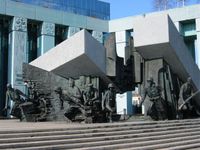
Most soldiers of the Home Army (including those who took part in the Warsaw Uprising) were persecuted after the war: captured by the NKVD or UB political police, interrogated and imprisoned, awaiting trials on various charges. Many of them were sent to Gulags, executed or just "disappeared".
In addition, members of the Polish Air Force flying supplies to the Home Army, were likewise persecuted after the war and many others "disappeared" after their return to Poland. Once word got back to the Polish flyers still in England, many decided not to return to Poland. Many insurgents, captured by the Germans and sent to POW camps in Germany were later liberated by British, American and Polish forces and remained in the West. Among those were the leaders of the uprising: Tadeusz Bór-Komorowski and Antoni Chruściel (in London and the United States, respectively).
Factual knowledge of the Warsaw Uprising, inconvenient to Stalin, was twisted by propaganda of the People's Republic of Poland, which stressed the failings of the Home Army and the Polish government-in-exile, and forbade all criticism of the Red Army or the political goals of Soviet strategy. Until the late sixties the very name of the Home Army was censored, and most films and novels covering the 1944 Uprising were either banned or modified so that the name of the Home Army did not appear. Further, the official propaganda of both communist Poland and the USSR suggested that the Home Army was some sort of a group of right-wing collaborators with Nazi Germany. From 1956 on, the image of the Warsaw Uprising in Polish propaganda was changed a little bit to underline that the soldiers were indeed brave, while the officers were treacherous and the commanders were characterised by disregard of the losses. The first serious publications on the topic were not issued until the late eighties. In Warsaw no monument to the Home Army could be built until 1989. Instead, efforts of the Soviet-backed Armia Ludowa were glorified and exaggerated.
In the West, the story of the Polish fight for Warsaw with little support was an embarrassment, as was the shock of Home Army soldiers as Western Allies recognised the Soviet controlled pro-Communist regime installed by Stalin; as a result, the story was not publicised for many years.
The courage of soldiers and civilians involved in the Warsaw Uprising, and its betrayal by the Soviet Union, contributed to keeping anti-Soviet sentiment in Poland at a high level throughout the Cold War. Memories of the Uprising helped to inspire the Polish labour movement Solidarity, which led a peaceful opposition movement against the Communist government during the 1980s, leading to the downfall of that government in 1989 and the emergence of democratic political representation.
After fall of communism in 1989, the censorship of the facts of the Uprising ceased, and 1 August has now become a celebrated anniversary. On 1 August 1994, Poland held a ceremony commemorating the 50th anniversary of the Uprising. Germany and Russia were invited to the ceremony, although there was opposition to Russia's invitation. Moreover, a joke making the rounds suggested that "Yeltsin should be given a pair of binoculars so he can observe the ceremony from across the Vistula river." On July 31, 2004, a Warsaw Uprising Museum opened in Warsaw.
Research into the Warsaw Uprising has been boosted since the 1990s, particularly due to abolition of censorship and opening of state archives in Poland, however research into the lack of support of the Warsaw Uprising is (according to historians such as Norman Davies)is still very difficult due to lack of access to archives in both UK and Russia. For records related to the period, currently both the United Kingdom archives and Russian archives (where the majority of Soviet archives are kept) remain mostly closed to the public. Further complicating the matter is the United Kingdom's claim that they accidentally destroyed the archives of the Polish Government in Exile.

